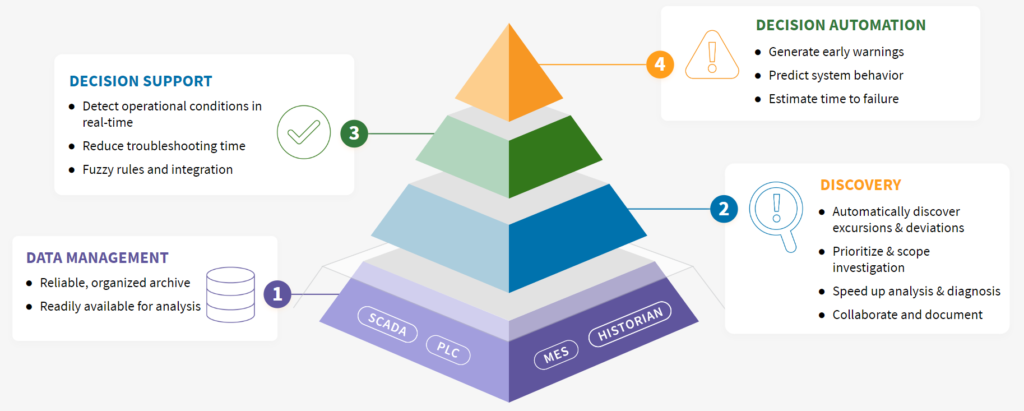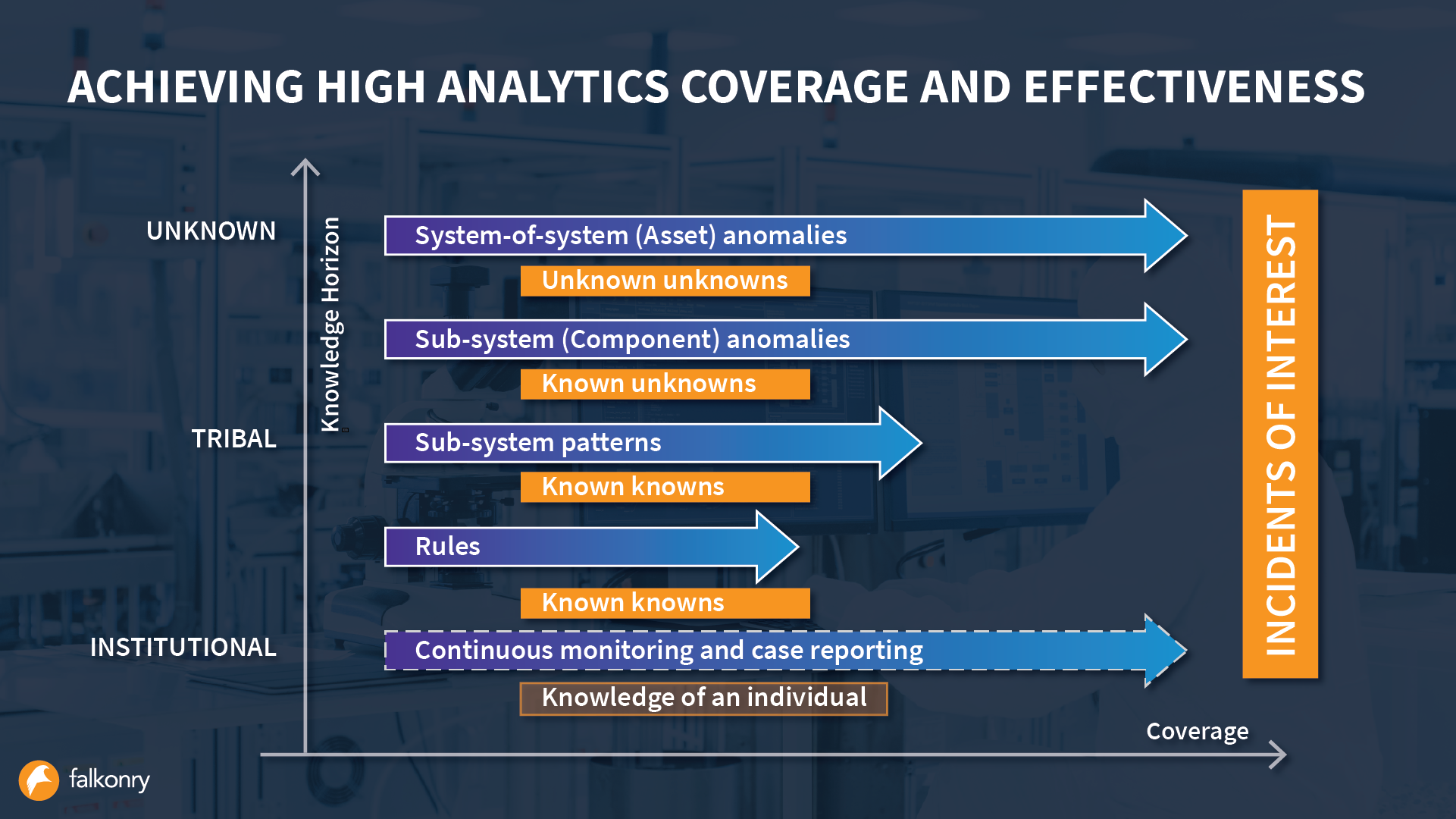Falkonry’s Smart Pyramid Framework For Advancing Manufacturing Excellence
Key takeaways:
- Ramping up analytics in manufacturing operations can be challenging due to their inherent complexity and limited scalability.
- Falkonry’s smart pyramid comprising Data Management, Discovery, Decision Support, and Decision Automation provides a roadmap for manufacturers to unlock hidden insights, drive decisions, and advance operational excellence.
- The high success rate of this approach hinges on the Discovery layer which encompasses anomaly detection. It creates the foundation upon which organizations can build their analytics capabilities.
In today’s complex manufacturing landscape, scaling advanced analytics across the organization to enhance operational efficiency can be a daunting task. However, Falkonry’s innovative smart pyramid approach provides a comprehensive roadmap for manufacturers to unlock hidden insights, drive informed decisions, and advance operational excellence. This framework comprises four key layers: Data Management, Discovery, Decision Support, and Decision Automation. Among these layers, the Discovery layer, centered around anomaly detection, plays a pivotal role in enabling organizations to build robust analytics capabilities. By unearthing hidden insights and shedding light on process stability and equipment conditions, the Discovery layer serves as the foundation upon which manufacturers can advance their operations and drive transformative improvements. This blog explores Falkonry’s smart pyramid framework and how each layer contributes to accelerating smart manufacturing.

Data Management: Laying the foundation for analysis
The foundation of successful smart analytics lies in consistent data management. Falkonry’s analytics framework is built to exploit the data manufacturers are already producing in their PLC and SCADA systems. However, a significant challenge arises because these data sources were not originally intended for in-depth analysis and so the data must be brought into an analytical environment. This data management layer acts as a bridge, extracting the data from the PLC and SCADA systems and transferring it to a dedicated analytical environment. By doing so, it ensures the data is optimized for analysis and readily visible to experts for confirming the results of the analysis. By seamlessly integrating with data historians and other off-the-shelf industrial data middleware, Falkonry provides an out-of-the-box, ready-to-integrate, and secure connectivity solution. This eases the upfront struggles of software development and robust data flow management.
Discovery: Unearthing insights for actionable intelligence
The second layer of the pyramid framework is Discovery – the most crucial layer for manufacturers seeking operational excellence. It encompasses the discovery of excursions and deviations, prioritizing and scoping investigations, speeding up analysis and diagnosis, and fostering collaboration and documentation. Anomalies shed light on undetected events in your data and provide a unique way to understand underlying process stability and equipment condition issues. We’ve always maintained that finding a needle in a haystack of data is only half the problem. Discovering all of the types of needles that can exist in said haystack is where the true value lies. Anomaly detection helps organizations create that inventory of needles.
Conventional anomaly detection focuses on control bands (upper and lower limits) and these prove to be hard to set up/maintain for avoiding business impact. Through advanced analytics and artificial intelligence (AI) capabilities, manufacturers are extracting actionable insights from anomalies and gaining a deeper and more complete understanding of their operations. Discovery paves the way for informed decision-making and sets the stage for transformative improvements. This simple awareness – that aha moment of realizing “Hey, something doesn’t look right here” marks the inflection point for ascending the pyramid framework.
Decision Support: Enabling real-time operational awareness
The third layer of the pyramid, Decision Support, takes operational awareness to new heights. By detecting real-time operational conditions, reducing troubleshooting time, and simplifying integration, manufacturers gain a powerful toolset to optimize their processes. Decision Support enables manufacturers to make data-driven decisions and drive continuous improvements throughout their operations.
Decision Automation: The goal of smart manufacturing
At the pinnacle of the pyramid framework lies Decision Automation – the ultimate goal for manufacturers seeking to maximize productivity. By leveraging the entire Falkonry Time Series AI Cloud, manufacturers can generate early warnings, monitor system behavior, and look for specific patterns to anticipate failure. This allows practitioners to proactively address potential issues, avoid downtime, and streamline maintenance planning. Decision Automation empowers manufacturers to reach unprecedented levels of maintenance efficiency by leveraging AI-generated predictive insights.
Putting the framework to use
The roadmap we have discussed so far provides a comprehensive approach to solving productivity and complexity challenges in the manufacturing industry. It shows a clear path for how manufacturers can harness the full potential of their operational data, uncover hidden insights, and make informed decisions – the entire basis for which is anomaly detection. However, in the course of our conversations with both our existing customers and industry practitioners, we noticed that many manufacturers commonly aimed for success by focusing solely on the top of the pyramid i.e. a specific aspect of their operations. They soon discovered that this approach had its limitations. Although their intentions were commendable, achieving the goal of estimating time to failure was nearly impossible, resulting in a considerable waste of time and resources. Efforts in that direction more often than not prove insufficient to drive meaningful progress within the desired timeframe for organizations.
This is where Falkonry asks a crucial question: Why aren’t manufacturing organizations considering the broader operational context in which value can be created? Operational and asset data exists, from both productivity and maintenance perspectives, but rarely do the two meet. Identifying process and asset anomalies, understanding their correlations, and obtaining the necessary identifiers allows an organization to automate the complex, and sometimes elusive task of exposing and warning of potential failures.
Hence, it bodes well for organizations to let computational systems find information from operational data that they can act on without upfront effort. This enables them to confidently know more and cover a larger span of operational challenges. That’s where Falkonry has focused – the Discovery layer which encompasses anomaly detection. It also happens to be the place where most organizations should start their analytics journey.
To learn more about how anomalies can result in tangible operational improvements, click here.





